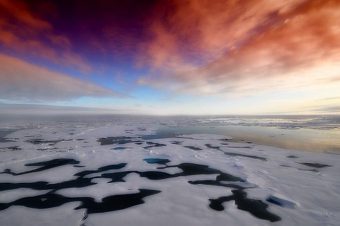
The Arctic region experienced its second-warmest year (by air temperature) and its lowest winter sea ice extent on record in 2017, according to the 12th edition of NOAA’s Arctic Report Card.
The peer-reviewed report — comprising the work of 85 different researchers from 12 different countries — also revealed that the Arctic is continuing to warm at a rate roughly or greater than twice that of most of the rest of the world.
The only year where land temperatures in the region were hotter than in 2017 was 2016 — air temperatures in the region were on average a good 2.9° Fahrenheit (1.6° Celsius) higher during 2017 than the 1981–2010 average for the region.
The region also experienced its lowest ever (since modern record keeping began, that is) winter sea ice extent — with the maximum during March 2017 being substantially more limited than during any years on record. 2017’s maximum sea ice extent represents the 8th lowest on record — with almost all of those ahead of 2017 being post-2000 years.
Overlapping all of that, Arctic sea ice is continuing to get thinner and younger by the year — with multi-year sea ice now representing just 21% of total extent, down from 45% in 1985.
Sea surface temperatures are continuing to rise rapidly as well — with August 2017 sea surface temperature averages in the Barents and Chukchi seas being 7.2° Fahrenheit (4° Celsius) above the long-term average. The surface waters of the Chukchi Sea have actually increased in temperature by around 1.26° Fahrenheit (0.7° Celsius) per decade since 1982.
The press release details a couple of other interesting data points:
— Arctic ocean plankton blooms increasing. Springtime melting and retreating sea ice which allows sunlight to reach the upper layers of the ocean, continues to stimulate increased chlorophyll as measured by satellite, which indicates more marine plant growth across the Arctic. This increase has occurred since measurements began in 2003.
— Greener tundra. Overall vegetation, including plants getting bigger and leafier, and shrubs and trees taking over grassland or tundra, increased across the Arctic in 2015 and 2016, as measured by satellite. The greatest increases over the last 3 decades are occurring on the North Slope of Alaska, Canada’s tundra, and Taimyr Peninsula of Siberia. The annual report on vegetation is based largely on data from sensors aboard NOAA weather satellites.
— Snow cover up in Asia, down in North America. For the 11th year in the past 12, snow cover in the North American Arctic was below average, with communities experiencing earlier snow melt. The Eurasian part of the Arctic saw above average snow cover extent in 2017, the first time that’s happened since 2005.
— Less melt on Greenland Ice Sheet. Melting began early on the Greenland Ice Sheet in 2017, but slowed during a cooler summer, resulting in below-average melting when compared to the previous 9 years. Overall, the Greenland Ice Sheet, a major contributor to sea level rise, continued to lose mass this past year, as it has since 2002 when measurements began.
“The rapid and dramatic changes we continue to see in the Arctic present major challenges and opportunities,” stated retired Navy Rear Admiral Timothy Gallaudet, the acting NOAA administrator. “This year’s Arctic Report Card is a powerful argument for why we need long-term sustained Arctic observations to support the decisions that we will need to make to improve the economic well-being for Arctic communities, national security, environmental health, and food security.”
Major challenges and opportunities? I guess at this point it’s no mystery — every country from the US, to Norway, to Russia, to Denmark, to Canada, to China is gearing up to compete for Arctic resources as the climate continues warming. Such resources should probably remain undeveloped — if extreme anthropogenic climate warming and weirding is to be avoided, then they will essentially have to be, that is.
Since I’ve already written a rather long article on the subject, I’ll keep it fairly brief here — even after the Arctic region warms substantially, it will not be well suited to human habitation. To put that another way, the sorts of population numbers that the Arctic region will be able to support after warming will be very limited — perhaps even lower than they are now as the result of fisheries possibly collapsing and the disappearance of high-calorie game (seals, caribou, etc.)
The “soil” of the region is largely non-existent, and what does exist is quite poorly suited to agriculture. It’s not simply a matter of populations moving northwards as the tropics warm and bringing their lifestyles with them — the Arctic is a fundamentally different place. It’s not simply a matter of the temperatures being somewhat lower there.
Source: cleantechnica.com

